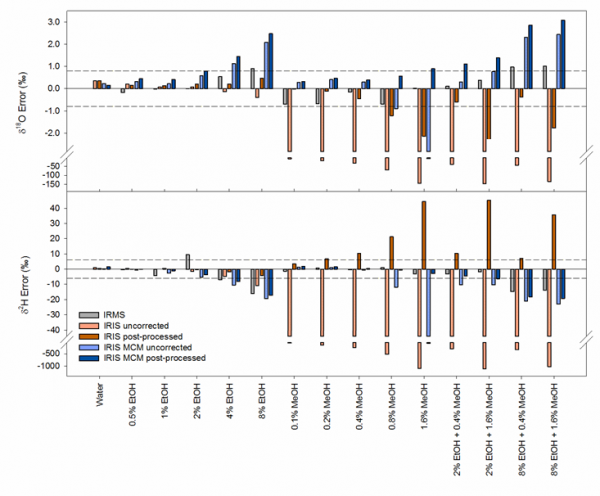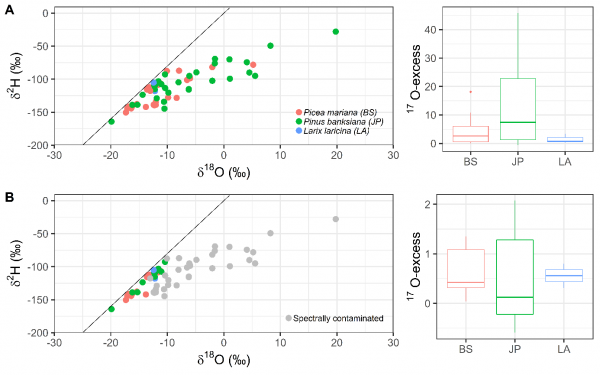Dies ist eine alte Version des Dokuments!
Plant water source acquisition: Improving resolution and accuracy in isotopic analysis
Stable isotopes of water (2H, 17O and 18O) are useful tracers for investigating plant water sources, but traditional isotopic measurements via destructive sampling of plant waters are expensive and labor intensive 1,2. Isotope-ratio infrared spectroscopy (IRIS) offers a cheaper alternative and has shown potential to overcome limitations imposed by traditional methods 3,4. However, laser spectroscopic measurements of plant or soil waters can be significantly limited by spectral interferences caused by organic compounds such as methanol or ethanol 5 (Fig. 1), and even small quantities of contaminants (e.g. methanol) can generate a significant deviation from real values (Fig. 2). In this regard, organics can be co-extracted during cryogenic vacuum extraction and vapor equilibration method, which are the most common methods to sample and measure water from soil and plant samples. Recently in situ techniques have been employed to overcome limited temporal observations by increasing sampling frequency and observe dynamic water uptake processes in plants. However, the interference of organic compounds in both liquid and vapor methods hampers our ability to understand plant water uptake dynamics. In an attempt to solve this problem, IRIS manufacturers have developed software applications that identify and flag contaminated samples; however, the possibility to apply a correction to the contaminated samples has not been widely developed for different lasers and type of sample (liquid vs. vapor).
 Fig. 1: Errors for (a) oxygen and (b) hydrogen stable isotope composition (δ18O and δ2H, respectively, in ‰) associated with various methanol (MeOH) and ethanol (EtOH) concentrations in alcohol–water mixtures 4.
Fig. 1: Errors for (a) oxygen and (b) hydrogen stable isotope composition (δ18O and δ2H, respectively, in ‰) associated with various methanol (MeOH) and ethanol (EtOH) concentrations in alcohol–water mixtures 4.
 Fig. 2. Xylem samples in dual isotope ratio space and respective 17O‐excess (per meg): (A) results for all species showing spectral contamination in dual isotope space; (B) the same samples, but distinguishing between spectrally contaminated (grey) identified visually on the ‘spectral fit residual plot‘, and not contaminated.
Fig. 2. Xylem samples in dual isotope ratio space and respective 17O‐excess (per meg): (A) results for all species showing spectral contamination in dual isotope space; (B) the same samples, but distinguishing between spectrally contaminated (grey) identified visually on the ‘spectral fit residual plot‘, and not contaminated.
Aim and research questions
In this study, we will evaluate plant waters extracted via different techniques (liquid and water vapor) on two different IRIS systems ( WS-CRDS from Picarro Inc. and OA-ICOS from Los Gatos Research Inc.), with a focus on spectral contamination introduced by organic compounds. We will use a set of methanol (MeOH) and ethanol (EtOH) solutions together with naturally contaminated samples to assess errors in isotope measurements. We will evaluate whether:
- both laser spectroscopes flag contaminated samples in the same way
- there are differences between vapor and liquid measurements with respect to organic contamination
- 17O isotope or other spectral variables measured can be indicators for organic contamination on both laser spectroscopes running in vapor mode
- contamination across different times of the year (spring vs summer) and species occurs
- we can develop a post-processing correction protocol for contaminated samples for both lasers in liquid and vapor mode
Against this background, the potential candidate would:
- Sample different plant species at different times of the year
- Compare extracted water samples (liquid and vapor) on both laser spectroscopes
- Identify indicators for organic contamination that can be used to correct isotope data from both laser spectroscopes
Challenges
The student/s should be interested in conducting field and lab work and be familiar with statistical software, such as R or Python.
Supervision/Contact
Natalie Orlowski: natalie.orlowski@hydrology.uni-freiburg.de; Tel. 0761 - 203-9283 This project is in collaboration with Magali Nehemy (Global Institute for Water Security, Saskatoon, CA) and Paula Martín-Gómez (INRA Bordeaux, FR)
Language
English
Literature
- Orlowski, N., Pratt, D. L. & McDonnell, J. J. Intercomparison of soil pore water extraction methods for stable isotope analysis. Hydrol. Process. 30, 3434–3449 (2016).
- Millar, C., Pratt, D., Schneider, D. J. & McDonnell, J. J. A comparison of extraction systems for plant water stable isotope analysis. Rapid Commun. Mass Spectrom. 32, 1031–1044 (2018).
- Nehemy, M. F. et al. 17O- excess as a detector for co-extracted organics in vapor analyses of plant isotope signatures. Rapid Communications in Mass Spectrometry 0, (2019).
- Martín-Gómez, P. et al. Isotope-ratio infrared spectroscopy: a reliable tool for the investigation of plant-water sources? New Phytol 207, 914–927 (2015).
- West, A. G., Goldsmith, G. R., Brooks, P. D. & Dawson, T. E. Discrepancies between isotope ratio infrared spectroscopy and isotope ratio mass spectrometry for the stable isotope analysis of plant and soil waters. Rapid Commun. Mass Spectrom. 24, 1948–1954 (2010).